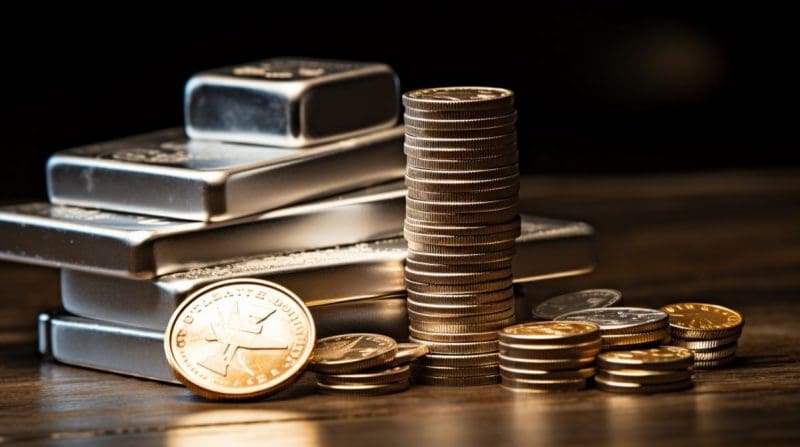
In the intricate world of precious metals, silver stands as a time-honored asset that has captivated investors for centuries.
Its unique properties, coupled with its diverse applications, make it a commodity of significant interest.
This article delves into the market dynamics surrounding silver, exploring the factors that influence its value and dissecting various investment strategies that individuals employ when navigating the silver market.
Market Dynamics of Silver:
Industrial Demand:
One of the key drivers of the silver market is its extensive use in various industrial applications. From electronics and solar panels to medical devices, silver plays a crucial role in modern manufacturing. Fluctuations in industrial demand can significantly impact the overall supply-demand dynamics, influencing silver prices.
Investor Sentiment:
The sentiment of investors, both institutional and individual, plays a pivotal role in shaping the silver market. Economic uncertainties, geopolitical tensions, and inflationary concerns often drive investors towards precious metals as a safe-haven asset. Silver, with its dual role as an industrial metal and a store of value, is particularly sensitive to shifts in investor sentiment.
Currency Strength:
Silver, like other precious metals, is denominated in fiat currencies. Therefore, the strength or weakness of major currencies, especially the U.S. Dollar, can influence silver prices. When the dollar weakens, silver prices may rise as it becomes relatively more attractive to investors using other currencies.
Mining Production:
The supply side of the silver market is closely tied to mining production. Changes in mining output, influenced by factors such as mining costs, technology advancements, and geopolitical considerations, can impact the overall supply of silver. Production disruptions or increased mining efficiency can lead to shifts in silver prices.
Investment Strategies in the Silver Market:
Physical Silver Investments:
Acquiring physical silver, in the form of coins, bars, or rounds, is a traditional and tangible way to invest in the metal. Many investors value the security and tangibility of holding physical silver, considering it a hedge against economic uncertainties. Storing silver securely or incorporating it into a precious metals portfolio are common strategies for physical silver investors.
Silver ETFs and Mutual Funds:
Exchange-Traded Funds (ETFs) and mutual funds offer investors exposure to the silver market without the need for physical ownership. These investment vehicles hold silver assets, providing a convenient way for investors to gain indirect exposure to silver price movements. It is a more liquid and easily tradable option for those who prefer a hands-off approach.
Silver Mining Stocks:
Investing in companies engaged in silver mining provides an avenue to capitalize on potential price increases while leveraging the growth potential of mining operations. However, this strategy comes with additional risks related to company-specific factors, such as operational efficiency, management practices, and geopolitical considerations.
Options and Futures Trading:
For more sophisticated investors, options and futures contracts on silver offer a way to speculate on price movements. These financial instruments provide the opportunity to profit from both rising and falling silver prices. However, they also involve a higher level of risk and require a deep understanding of market dynamics.
Numismatic Silver:
Numismatic silver refers to coins with historical or collector value beyond their metal content. Collectors often seek rare or limited-edition silver coins, considering them not only as an investment but also as a piece of history. Numismatic silver can have a value premium beyond the spot price of silver.
Systematic Investment Plans:
A systematic approach involves regularly investing a fixed amount in silver over time. This strategy, commonly known as dollar-cost averaging, helps mitigate the impact of short-term price fluctuations. Investors benefit from buying more silver when prices are low and less when prices are high, potentially reducing the average cost per ounce over time.
Conclusion:
Selling silver is not merely a transaction; it’s a journey through the intricate dynamics of a market influenced by industrial demand, investor sentiment, currency strength, and mining production. When you choose to sell silver online, you embark on a nuanced exploration of a market shaped by various factors that impact the value of this precious metal. Successful investors in the silver market carefully navigate these factors, employing diverse strategies tailored to their financial goals and risk tolerance.
Whether through physical ownership, ETFs, mining stocks, trading derivatives, or collecting numismatic pieces, the silver market offers a spectrum of opportunities for investors. As the global economy evolves and market dynamics shift, the allure of silver as a precious metal and investment option persists. A deep dive into these dynamics, coupled with a strategic approach, positions investors to make informed decisions in the ever-evolving landscape of silver trading and investment.
